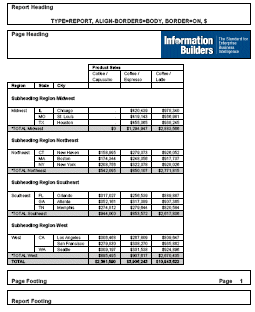Syntax: How to Add and Format Borders
To request a uniform border, use this syntax:
TYPE=type, BORDER=option, [BORDER-STYLE=line_style,]
[BORDER-COLOR={color|RGB(r g b)},] $To specify different characteristics for the top, bottom, left, and/or right borders, use the syntax
TYPE=type, BORDER-position=option,
[BORDER[-position]-STYLE=line_style,]
[BORDER[-position]-COLOR={color|RGB(r g b)},] $
where:
- type
-
Identifies the report component to which borders are applied.
- option
-
Can be one of the following values:
ON turns borders on. ON generates the same line as MEDIUM.
Note: The MEDIUM line setting ensures consistency with lines created with GRID attributes.
OFF turns borders off. OFF is the default value.
LIGHT specifies a thin line.
MEDIUM identifies a medium line. ON sets the line to MEDIUM.
HEAVY identifies a thick line.
width specifies the line width in points, where 72 pts=1 inch.
Tip: Line width specified in points is displayed differently in HTML and PDF output. For uniform appearance, regardless of display format, use LIGHT, MEDIUM, or HEAVY.
- position
-
Specifies which border line to format. Valid values are: TOP, BOTTOM, LEFT, RIGHT.
You can specify a position qualifier for any of the BORDER attributes. This enables you to format line width, line style, and line color individually, for any side of the border.
- line_style
-
Sets the style of the border line. FOCUS StyleSheets support all of the standard cascading style sheet line styles. Several 3-dimensional styles are available only in HTML, as noted by asterisks. Valid values are:
Style
Description
NONE
No border is drawn.
SOLID
Solid line.
DOTTED
Dotted line.
DASHED
Dashed line.
DOUBLE
Double line.
GROOVE*
3D groove.
RIDGE*
3D ridge.
INSET*
3D inset.
OUTSET*
3D outset.
- color
-
Is one of the preset color values. The default value is BLACK.
If the display or output device does not support colors, it substitutes shades of gray. For a complete list of available color values, see Color Values in a Report.
- RGB
-
Specifies the font color using a mixture of red, green, and blue.
- (r g b)
-
Is the desired intensity of red, green, and blue, respectively. The values are on a scale of 0 to 255, where 0 is the least intense and 255 is the most intense. Using the three color components in equal intensities results in shades of gray.
Example: Inserting and Formatting a Border
This request generates an HTML report with a heavy red dotted line around the entire report heading.
TABLE FILE GGSALES
SUM BUDUNITS UNITS BUDDOLLARS DOLLARS
BY CATEGORY
ON TABLE SUBHEAD
"</1 Sales Report"
"**CONFIDENTIAL**"
"December 2002 </1"
ON TABLE SET PAGE-NUM OFF
ON TABLE HOLD FORMAT HTML
ON TABLE SET HTMLCSS ON
ON TABLE SET STYLESHEET *
TYPE=REPORT, GRID=OFF, $
TYPE=TABHEADING, STYLE=BOLD, JUSTIFY=CENTER, BORDER=HEAVY,
BORDER-COLOR=RED, BORDER-STYLE=DOTTED, $
ENDSTYLE
END
The output is:

Tip: You can use the same BORDER syntax to generate this output in a PDF or PS report.
Example: Applying Grid Lines to All Cells of an HTML Report
This request uses GRID=FILL to apply grid lines to all cells, including those underneath the sort field CATEGORY. With GRID=ON, the cells underneath the sort field value do not have grid lines until the sort field value changes.
TABLE FILE GGSALES SUM UNITS DOLLARS BY CATEGORY BY PRODUCT ON TABLE SET PAGE-NUM OFF ON TABLE HOLD FORMAT HTML ON TABLE SET STYLE * TYPE=REPORT, GRID=FILL, $ ENDSTYLE END
All cells have grid lines:








